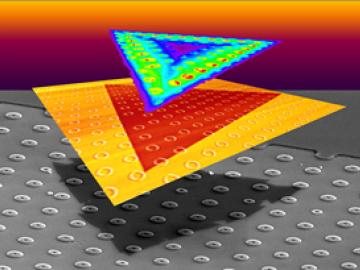
Filter News
Area of Research
- (-) Biology and Environment (17)
- (-) Materials (39)
- (-) Quantum information Science (9)
- Advanced Manufacturing (2)
- Building Technologies (3)
- Computational Engineering (1)
- Computer Science (10)
- Electricity and Smart Grid (3)
- Energy Science (141)
- Functional Materials for Energy (1)
- Fusion and Fission (8)
- Fusion Energy (7)
- Materials for Computing (8)
- National Security (23)
- Neutron Science (16)
- Nuclear Science and Technology (11)
- Nuclear Systems Modeling, Simulation and Validation (1)
- Sensors and Controls (1)
- Supercomputing (50)
- Transportation Systems (2)
News Topics
- (-) Advanced Reactors (4)
- (-) Buildings (5)
- (-) Grid (9)
- (-) Machine Learning (12)
- (-) Quantum Science (20)
- (-) Transportation (15)
- 3-D Printing/Advanced Manufacturing (27)
- Artificial Intelligence (15)
- Big Data (11)
- Bioenergy (53)
- Biology (74)
- Biomedical (20)
- Biotechnology (14)
- Chemical Sciences (36)
- Clean Water (14)
- Composites (11)
- Computer Science (40)
- Coronavirus (14)
- Critical Materials (13)
- Cybersecurity (7)
- Energy Storage (37)
- Environment (102)
- Exascale Computing (6)
- Frontier (6)
- Fusion (8)
- High-Performance Computing (24)
- Hydropower (8)
- Irradiation (1)
- Isotopes (13)
- ITER (1)
- Materials (78)
- Materials Science (82)
- Mathematics (4)
- Mercury (7)
- Microscopy (36)
- Molten Salt (3)
- Nanotechnology (43)
- National Security (5)
- Neutron Science (36)
- Nuclear Energy (16)
- Partnerships (13)
- Physics (30)
- Polymers (18)
- Quantum Computing (3)
- Security (3)
- Simulation (16)
- Space Exploration (2)
- Summit (11)
Media Contacts

Using additive manufacturing, scientists experimenting with tungsten at Oak Ridge National Laboratory hope to unlock new potential of the high-performance heat-transferring material used to protect components from the plasma inside a fusion reactor. Fusion requires hydrogen isotopes to reach millions of degrees.

Scientists at Oak Ridge National Laboratory studying quantum communications have discovered a more practical way to share secret messages among three parties, which could ultimately lead to better cybersecurity for the electric grid

A team of researchers at Oak Ridge National Laboratory have demonstrated that designed synthetic polymers can serve as a high-performance binding material for next-generation lithium-ion batteries.

Oak Ridge National Laboratory physicists studying quantum sensing, which could impact a wide range of potential applications from airport security scanning to gravitational wave measurements, have outlined in ACS Photonics the dramatic advances in the field.

A team led by scientists at the Department of Energy’s Oak Ridge National Laboratory explored how atomically thin two-dimensional (2D) crystals can grow over 3D objects and how the curvature of those objects can stretch and strain the

OAK RIDGE, Tenn., May 7, 2019—Energy Secretary Rick Perry, Congressman Chuck Fleischmann and lab officials today broke ground on a multipurpose research facility that will provide state-of-the-art laboratory space

Oak Ridge National Laboratory scientists studying fuel cells as a potential alternative to internal combustion engines used sophisticated electron microscopy to investigate the benefits of replacing high-cost platinum with a lower cost, carbon-nitrogen-manganese-based catalyst.

Carbon fiber composites—lightweight and strong—are great structural materials for automobiles, aircraft and other transportation vehicles. They consist of a polymer matrix, such as epoxy, into which reinforcing carbon fibers have been embedded. Because of differences in the mecha...

Oak Ridge National Laboratory scientists have developed a crucial component for a new kind of low-cost stationary battery system utilizing common materials and designed for grid-scale electricity storage. Large, economical electricity storage systems can benefit the nation’s grid ...


